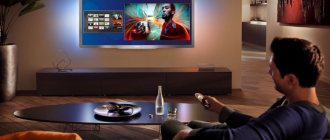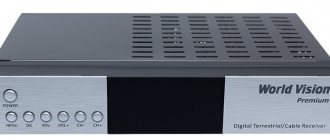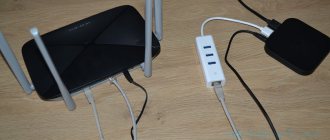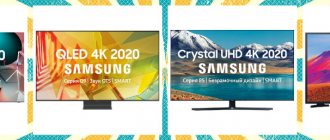Although televisions are losing popularity in the electronics market, the decline in sales does not look threatening at all. With Russia's transition to digital broadcasting, a large number of households became interested in new TV receivers. Most modern TVs have built-in Wi-Fi and Smart TV. What it is? Let's figure it out now.
- What is a TV with Wi-Fi
- Why do you need Wi-Fi on a TV?
- How Wi-Fi works on TV
- TV with WiFi and Internet: advantages and disadvantages
- Types of TVs with Internet
- How to choose a TV with Wi-Fi
- The best TVs with Internet and Wi-Fi – prices and ratings
- How to connect Wi-Fi on TV
What is a TV with Wi-Fi
The concept of Smart TV implies that the TV has advanced functionality. If previously a TV receiver was used only as a tool for broadcast television or, at most, for watching a movie from a flash drive, now many devices are completely on par with the smartphones we are used to in their capabilities. A Smart TV has its own operating system that allows you to download applications to consume content. Thus, the user can perform almost the full range of actions, as is the case with a smartphone.
No smartphone can be imagined without the Internet. It is the global network that allows you to download software and other content. Of course, smart TVs also have a similar function. And in order not to bother with running an Internet cable throughout the apartment, modern TV receivers are equipped with a Wi-Fi module for receiving a wireless signal.
Wi-Fi is a wireless network technology that allows you to distribute the Internet to other devices with an appropriate sensor through a router.
Usage
Now we’ll tell you how to use a smart TV. Smart control is carried out in two main ways:
- remote control;
- smartphone.
If everything is clear with the first case, everyone used the remote control, then we will reveal the second in more detail. To control TV from a smartphone, which is convenient when surfing social networks and games, you need to install the appropriate software. One such program for Android is Smart TV Remote. To switch devices, both must support Direct Wi-Fi technology.
Why do you need Wi-Fi on a TV?
By itself, Wi-Fi on a TV receiver is a useless feature. Therefore, all TVs with Wi-Fi sensors are equipped with Smart TV technology, which allows you to use functions similar to those found on a smartphone.
Wi-Fi allows the TV owner to access the Internet through a browser, watch movies on various online services, and even play games. True, buying a TV receiver with a Smart TV function should not be considered as an ideal solution for gaming. As a rule, the processor built into the TV is very weak. It can only play very basic games.
But in terms of other smart functions, a TV receiver with Wi-Fi is a very useful thing. A person does not need to run a large number of cables throughout the house. It is enough to connect the TV to the router via a wireless network, after which the owner of the device will have access to the Internet.
Differences of the built-in module
What network driver is needed for Windows 7 for the Internet to work?
Internet access via the built-in adapter has its own specific features and subtleties.
Note! The key nuance is that when setting it up, it is impossible to take advantage of all the qualities of a computer or laptop.
Besides this, there are other pros and cons:
- Access to the World Wide Web is limited to certain sites only. Some of them create a special interface for TV. These include various social networks, databases with films, music sites and services like YouTube, etc.;
- you can make video calls, but only if you have a separate or built-in camera with a microphone;
- All movies do not need to be downloaded or saved to watch. Viewing takes place online.
How Wi-Fi works on TV
The technology is implemented in modern TV receivers in the same way as on smartphones and tablets. In this case, we are not talking about full-fledged computers, since a PC is a more complex device. And the functionality of a smartphone matches perfectly with a TV.
Of course, on the TV screen the user sees a different interface. Since TV displays are very rarely touch-sensitive, control is carried out using the remote control.
To connect Wi-Fi to a TV receiver, you will need to take care of purchasing a router if such a device has not previously been installed at home. A fiber optic cable is supplied to it from the provider, and the router itself distributes the Internet over the maximum distance that is possible in accordance with its technical characteristics.
TV with WiFi and Internet: advantages and disadvantages
To decide whether you need a TV receiver with Wi-Fi support, we recommend that you familiarize yourself with the advantages and disadvantages of such technology in TVs.
Advantages and disadvantages
Ability to use smart functions (connecting to the Internet, watching movies online, etc.)
Completely wireless connection, no additional cables required
Such models are slightly more expensive than regular TVs.
Controlling a TV receiver with Smart TV may not seem very convenient at first due to the interface features
The advantages of such devices are clear. We talked about this in detail at the very beginning of the material. It is much more important to explain whether the highlighted disadvantages are fatal. And let's start with the first thesis that TVs with Wi-Fi are more expensive. Yes, this is true if you compare models from the same manufacturers. On average, the markup is 15-20% compared to conventional TV receivers. But soon there will be no TVs left on the market without support for Smart TV and Wi-Fi, so this disadvantage can be forgotten.
As for management, everything comes with experience. A person who has previously used a regular TV receiver will probably get confused in the huge number of menu items. But over time, skill will come, and Smart TV will begin to be perceived as the most banal thing. In addition, manufacturers of operating systems for TVs are introducing new control methods. For example, by voice using the microphone built into the remote control.
What to look for when purchasing
When choosing a TV with WiFi and the Internet, you need to pay attention to the same parameters as with a regular TV. Let's highlight the main criteria:
- Display size. Models with screens from 17 inches and higher are available for sale. When calculating the optimal size, you need to consider the location from which you plan to watch TV. The distance should be equal to three diagonals. You can choose small TVs with Wi-Fi function, but they are more suitable for small rooms.
- Permission. The larger this parameter, the more dots on the screen, and the higher the clarity of the picture. There are TVs with Ultra HD on sale, but you can buy a TV with WiFi and Internet in Full HD. It would be enough.
- Viewing angle. Ideally, the optimal angle should be 180 degrees, but only a few manufacturers offer this option. On average, 165-175 degrees is enough.
- Flicker frequency. To avoid eye fatigue, manufacturers make TVs with the Internet and WiFi with a scanning frequency above 100 Hz. This is the best option. If this parameter is less than 100 Hz, your eyes will get tired.
- Matrix type. There are two options here - plasma, LCD and LED. The first type is the most durable, the second is the most affordable, and LED screens have better image quality and consume less energy.
- Connectors. It is important that a TV with WiFi and the Internet has enough inputs to connect a satellite dish, PC and other devices. Be sure to have several HDMI and USB connectors.
- Internet connection type. Smart TV can be connected via WiFi or Ethernet cable. The first option is more convenient, but it may slow down when viewing.
- Installed software. A TV with WiFi and the Internet may have pre-installed Android or Windows OS. The first solution is more attractive due to the presence of a larger selection of programs.
- 3D is an additional feature that allows you to watch movies and shows with a 3D effect. The downside is that you will have to pay extra for this option.
Knowing these principles, it is easier to choose a high-quality TV and not overpay.
Types of TVs with Internet
Accessing the Internet through a TV can be done in different ways. Let's talk in more detail about the most common ones to understand what to expect from such a device.
Wi-Fi support via built-in module
These are TVs with Smart TV technology. They have a Wi-Fi module on board, which allows you to connect to the Internet through the menu without using cables. But if necessary, you can pair using a patch cord (a special Internet cable) that runs from the router to the TV receiver.
Support via external adapter
If the TV does not have Smart TV technology, you will not be able to connect to the Internet through the built-in software. You will need to purchase an additional adapter that is inserted into the HDMI socket or smart set-top box with a Wi-Fi module.
This connection method is not very convenient, since a person has to allocate space for a new device (though it is small in size), face the problem of extra wires and not very convenient controls. To connect to the Internet, you must first open the TV settings, select the HDMI connector involved, take the remote control from the set-top box and connect through it using the smart device options.
If you need an Internet-enabled TV, do not purchase models without Smart TV. The difference with a more advanced model is exactly the same as the cost of a smart set-top box, which will cause a lot of inconvenience.
Principle of operation
Review and configuration of the D-Link Dir-320 modem
The principle of operation of TV equipment, which has a built-in ability to connect to a wireless network, is that there are no wires other than power from the outlet.
Note! All work on connection and information exchange is performed by the built-in module. Despite the increased price, such models are the most popular in the domestic home appliances market.
Although there are still TVs on sale without the ability to access the Internet. They cost less, but are no longer as interesting in everyday use as more modern models. For such devices, it is recommended to additionally purchase special adapters, preferably of the same brand. If this is not taken into account, the equipment may not operate correctly. However, it is best to buy a special router that, using a wired connection to the TV, receives the Wi-Fi signal and transmits it.
How to choose a TV with Wi-Fi
When going to the store to buy an Internet-enabled TV receiver, first pay attention to the “Smart TV” line in its characteristics. As we already figured out earlier, a device without smart TV technology requires the purchase of additional equipment.
Next, the potential buyer should consider the same criteria that are important when choosing a regular TV, namely:
- Diagonal.
- Screen resolution.
- Matrix.
- Viewing angles.
- Operating system.
- Built-in and RAM.
- Brand.
- Price.
As a rule, it doesn’t go further than diagonal, brand and price. But this is a wrong approach. It is important to pay attention to the screen resolution. With a diagonal of 40 inches or more, it is not recommended to take panels with a resolution lower than FullHD. And 4K will be relevant for large TVs.
The type of matrix also plays an important role. Each of them has its own advantages and disadvantages. You can learn about such details by paying attention to other characteristics. For example, maximum viewing angle. For TN matrices it is larger, but the image quality is not the best.
Be sure to look for additional features to improve the image if you are a television aesthete. But since all modern TV receivers display colors more or less well, the choice of operating system, processor and memory will be much more important. A lot depends on the OS. If you buy a TV from a well-known brand like Samsung or LG, then rest assured that the user will have access to a huge number of applications, and the interface will delight you with its friendliness.
If the choice falls on a model from a lesser-known brand, you should take a closer look at devices with Android TV. This is an advanced operating system that many people use on their smartphones.
The speed of the TV depends on the performance of the processor and the amount of RAM. And brand and price are subjective indicators that depend on the personal preferences of the buyer.
The best TVs with Internet and Wi-Fi – prices and ratings
In order not to have to worry about choosing a suitable TV receiver with wireless Internet support, we have collected the best models for 2020. The rating includes both expensive and very affordable TVs. They differ in diagonal, operating system and the presence of functions that improve the image. But they all have one thing in common - the optimal price-quality ratio.
Many TV models are available in several modifications, which differ only in screen size. Our rating presents versions with the smallest diagonal, and also indicates what other configurations exist.
Xiaomi Mi TV 4S 43
| Characteristic | Parameter |
| Diagonal | 43-75 inches |
| Matrix | IPS |
| Permission | 4K (3840x2160) |
| Viewing angle | 178° |
| Frame rate | 60 Hz |
| Response time | 8 ms |
| HDR support | Eat |
| Sound | 2x6 W, Dolby Digital |
| CPU | AMR Cortex-A53 |
| Memory | 1/8 GB |
| Dimensions | 964x606x233 mm |
| Weight | 7.6 kg |
| Price | From 23,000 rubles |
Inexpensive model from the famous company Xiaomi. The TV has high resolution and good matrix quality. True, the performance of the device is far from flagship level. With the ever-increasing demands of Smart TV applications, 1 GB of RAM in 3-4 years will not be enough to comfortably use the TV receiver.
LG 43UK6200
| Characteristic | Parameter |
| Diagonal | 43-75 inches |
| Matrix | IPS |
| Permission | 4K (3840x2160) |
| Viewing angle | 178° |
| Frame rate | 50 Hz |
| Response time | 9 ms |
| HDR support | Eat |
| Sound | 2x10 W, Dolby Digital, Ultra Surround |
| CPU | 4-core |
| Memory | 1/4 GB |
| Dimensions | 975x615x188 mm |
| Weight | 8.4 kg |
| Price | From 23,000 rubles |
An affordable TV with good sound, ideal for those who love a fully immersive movie experience. The proprietary WebOS operating system, which is used on LG TVs, guarantees maximum comfort during use, despite the presence of only 1 GB of RAM. But the quality of the matrix, even with high resolution, is not best suited for dynamic scenes.
LG OLED55C9
| Characteristic | Parameter |
| Diagonal | 55-77 inches |
| Matrix | OLED |
| Permission | 4K (3840x2160) |
| Viewing angle | 178° |
| Frame rate | 120 Hz |
| Response time | 1 ms |
| HDR support | Yes + Dolby Vision |
| Sound | 2x10 W + subwoofer 2x10 W, Dolby Atmos |
| CPU | 4-core |
| Memory | 3/8 GB |
| Dimensions | 1228x810x207 mm |
| Weight | 32 kg |
| Price | From 90,000 rubles |
One of the most advanced TVs on the market. The 2021 model has virtually no downsides. High resolution, high-quality matrix and unprecedented frame rate allow us to recommend the LG OLED55C9 to both movie lovers and avid gamers. And in terms of sound, the TV can completely outshine any competitors. However, the cost cannot be called affordable at all.
Samsung UE-43RU7400
| Characteristic | Parameter |
| Diagonal | 43-65 inches |
| Matrix | IPS |
| Permission | 4K (3840x2160) |
| Viewing angle | 178° |
| Frame rate | 60 Hz |
| Response time | Not indicated |
| HDR support | Eat |
| Sound | 2x10 W, Dolby Digital Plus |
| CPU | Not indicated |
| Memory | |
| Dimensions | 970x648x344 mm |
| Weight | 12.1 kg |
| Price | From 34,000 rubles |
A relatively inexpensive TV with a good matrix and the introduction of several image enhancement technologies. The model is also distinguished by high-quality sound and the presence of variations from 43 to 65 inches.
Samsung QE-49Q70R
| Characteristic | Parameter |
| Diagonal | 49-82 inches |
| Matrix | QLED |
| Permission | 4K (3840x2160) |
| Viewing angle | 178° |
| Frame rate | 60 Hz |
| Response time | Not indicated |
| HDR support | Eat |
| Sound | 2x10 W + subwoofer 2x10 W, Dolby Digital Plus |
| CPU | Not indicated |
| Memory | |
| Dimensions | 1095x708x248 mm |
| Weight | 14.1 kg |
| Price | From 60,000 rubles |
A model in the mid-price segment, offering the buyer high-quality sound and rich pictures. The TV comes with a subwoofer that enhances the sound.
Philips 50PUS6704
| Characteristic | Parameter |
| Diagonal | 50-70 inches |
| Matrix | V.A. |
| Permission | 4K (3840x2160) |
| Viewing angle | 178° |
| Frame rate | 50 Hz |
| Response time | Not indicated |
| HDR support | Yes + Dolby Vision |
| Sound | 2x10 W, Dolby Atmos |
| CPU | AMR Cortex-A53 |
| Memory | 2/4 GB |
| Dimensions | 1123x679x235 mm |
| Weight | 13.4 kg |
| Price | From 34,000 rubles |
One of the best price-quality ratios in our rating. It may not be the most expensive TV, but it has everything you need. At 50 inches, the resolution is equal to 4K, various image enhancement modes are supported, and built-in speakers allow you to feel completely immersed in the process. Moreover, the speed of the Android TV OS is not satisfactory.
Sony KD-49XF8596
| Characteristic | Parameter |
| Diagonal | 49-75 inches |
| Matrix | V.A. |
| Permission | 4K (3840x2160) |
| Viewing angle | 178° |
| Frame rate | 120 Hz |
| Response time | Not indicated |
| HDR support | Eat |
| Sound | 2x10 W, Dolby Digital |
| CPU | AMR Cortex-A53 |
| Memory | 2/16 GB |
| Dimensions | 1093x685x236 mm |
| Weight | 13.8 kg |
| Price | From 56,000 rubles |
Perhaps the best Sony TV at the moment. The device has a high resolution, excellent frame rate and a large number of features that improve the image. The TV is perfect for solving any tasks, and the amount of RAM makes a certain reserve for the future.
Asano 32LF7130S
| Characteristic | Parameter |
| Diagonal | 32 inches |
| Matrix | IPS |
| Permission | FullHD (1920x1080) |
| Viewing angle | 178° |
| Frame rate | 60 Hz |
| Response time | Not indicated |
| HDR support | No |
| Sound | 2x7 W, Dolby Digital |
| CPU | Not indicated |
| Memory | |
| Dimensions | 730x465x177 mm |
| Weight | 4 kg |
| Price | From 10,000 rubles |
The cheapest representative of our rating, which is the best in the price range up to 10 thousand rubles. The model has a good matrix with sufficient resolution for watching movies in high quality. Of course, the speed of operation is disappointing, but for that kind of money you won’t find a more powerful TV.
| Name | Description | Price | Rating |
| Sony KD-49XF8596 | The best TV with the Internet, which will delight you with both image quality and sound power. | From 56,000 rub. | ★★★★★ |
| LG OLED55C9 | The most advanced TV in the rating that will satisfy the needs of even the most sophisticated user. | From 90,000 rub. | ★★★★★ |
| Philips 50PUS6704 | A model with incredible image quality for its price. | From 34,000 rub. | ★★★★★ |
| LG 43UK6200 | The best TV in its price segment, with great sound and 4K resolution. | From 23,000 rub. | ★★★★★ |
| Samsung QE-49Q70R | A device with a subwoofer that allows you to watch movies at home no worse than in a cinema. | From 60,000 rub. | ★★★★★ |
| Samsung UE-43RU7400 | TV with good sound and high resolution | From 34,000 rub. | ★★★★★ |
| Xiaomi Mi TV 4S 43 | A good device from a Chinese company, pleasing with good picture quality. | From 23,000 rub. | ★★★★★ |
| Asano 32LF7130S | One of the most affordable TVs with Wi-Fi and Smart TV | From 10,000 rub. | ★★★★★ |
Most popular models
There are a large number of models and brands of smart TVs on the market. We will review some of them with pros, cons and prices.
ERISSON 19LES76T2
This is a small TV that is most often purchased for the kitchen. The device has a stylish design that will harmoniously fit into any interior. The device is equipped with a Vesa mount. Thanks to this, the receiver can be fixed to the wall using a bracket. Approximate cost: 7,500 rubles.
Characteristics:
- screen size – 19 inches;
- resolution – 1366*768;
- backlight – Edge LED.
Advantages:
- good sound;
- high-quality image;
- affordable price.
Flaws:
- slow loading speed of programs when switching;
- poor viewing angle.
Samsung UE22H5600
This is a small TV, which is also usually purchased for the kitchen. Approximate cost: 15,500 rubles.
Characteristics:
- screen size – 22 inches;
- resolution – 1920*1080;
- backlight – Edge LED;
- power – 38 W.
Advantages:
- high-quality image;
- good speed Smart TV;
- easy setup;
- stylish design.
Flaws:
- sound too quiet.
Mystery MTV-2430LTA2
This is a budget TV that provides Internet access. The device is equipped with an LED screen and has the following functions:
- TV Guide;
- noise suppression;
- teletext, etc.
Characteristics:
- screen size – 24 inches;
- backlight – Direct LED, which indicates good image quality and rich picture colors;
- resolution – 1366*768;
- power – 6 W;
- built-in memory – 8 GB;
- operating system – Android.
Advantages of the device:
- reasonable cost;
- light weight;
- good image quality.
Disadvantages of the device:
- The WI-FI module does not differ in power;
- small screen;
- not very good sound.
Such a SMART TV can be purchased for about 9,000 rubles.
Samsung UE32M5500AUXRU
This is a TV with Micro Dimming Pro local dimming technology. This means that the device's screen is divided into small segments where each image is analyzed. This improves the picture quality.
The TV also has the following features:
- PurColour - this function makes the shades saturated, but more natural;
- perspective effect - thanks to this, the picture acquires volume;
- The screen is equipped with an anti-glare coating.
How to connect Wi-Fi on TV
The TV is connected to Wi-Fi after the device is started for the first time. The owner of the equipment is immediately asked to enable network detection and connect to the home router, confirming pairing using a password. If the connection was not made immediately, you can perform the operation at any time through the TV receiver settings in the “Wireless network” or “Internet” section, depending on the model.
The operation is performed in a similar way if you have a smart set-top box connected to a regular TV. Just first you need to open the menu of the additional device, and then pair it through its settings.









